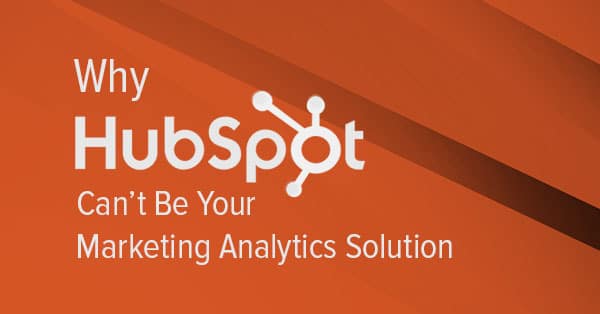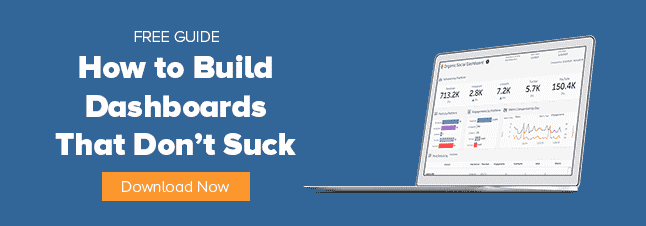If you use HubSpot, can’t you just treat it as your marketing analytics and reporting tool?
Good question. The answer, unfortunately, is no.
And I say that as a happy HubSpot customer! We use their platform to manage our demand generation efforts, and our team has been really pleased with it. They’ve been able to significantly streamline our email and social campaigns with HubSpot.
But HubSpot wasn’t built for in-depth reporting and insight. If analytics is an important part of your marketing strategy — and it should be — you need something different.
Why HubSpot Isn’t a Great Marketing Analytics Solution
To be clear, you can create basic reports with HubSpot. You’ll be able to use tracking URLs to see what sources are sending visitors to your HubSpot-powered landing pages. And the platform can track search and social performance, both paid and organic, if you connect your accounts to HubSpot. It offers a large and growing library of API-based connections to tools like Zoom, Eventbrite and Shopify.
For a small business, HubSpot might check all the boxes required for a reporting tool, especially if you’re strictly using digital channels and popular sources like Facebook and Twitter. But if your campaigns are big enough and sophisticated enough, you’re going to run into some pretty significant obstacles.
For starters, HubSpot doesn’t have integrations with every single marketing platform. It can be challenging to bring in data from offline channels like TV and radio. And that’s a problem for any marketer with a multi-channel approach to campaigns. You need to measure performance and spend for all the channels and tactics that you’re using.
Even if HubSpot does have an integration, it might not work like you want it to. Check out the reviews for HubSpot’s integrations with Zoom, Eventbrite and Shopify. You’ll find a lot of positive feedback, but you’ll also notice a lot of frustrated comments, too, from marketers who can’t access all their data or can’t use it in the way they choose.
To produce more advanced forms of analysis like cross-channel reporting, attribution and media mix modeling, you’ve got to be able to create a single source of truth for all your marketing data, unified with similar dimensions and metrics. HubSpot can’t support that.
And finally, you can’t customize your reporting’s visuals the way you could with a dedicated dashboard tool like Tableau or Power BI. Sounds picky, I know, but that kind of flexibility can really make a difference when you try to visualize more complex datasets.
When our team has tried to build custom reports, they’ve been limited to two dimensions. The result is reporting that has a severe lack of granularity. You only get a 30,000-foot view of performance.
HubSpot Wasn’t Built for This!
In the interests of fairness, I want to reiterate: HubSpot wasn’t really designed for analytics, the same way that other automation tools like Marketo and Eloqua weren’t designed for analytics.
They can report on part of your marketing investment. But they can’t give you the visibility you need to measure the effectiveness of multi-channel campaigns.
If you’re using other channels than just email, Google Ads and social, you’re going to need a dedicated analytics solution to bring it all together.
Try Alight’s Holistic Analytics Free for 30 days
Alight’s suite of holistic analytics solutions integrates data from your entire marketing ecosystem (including HubSpot and any other sales or marketing platform) as a single source of truth. Request your free 30-day solution evaluation to see our solutions in action!

